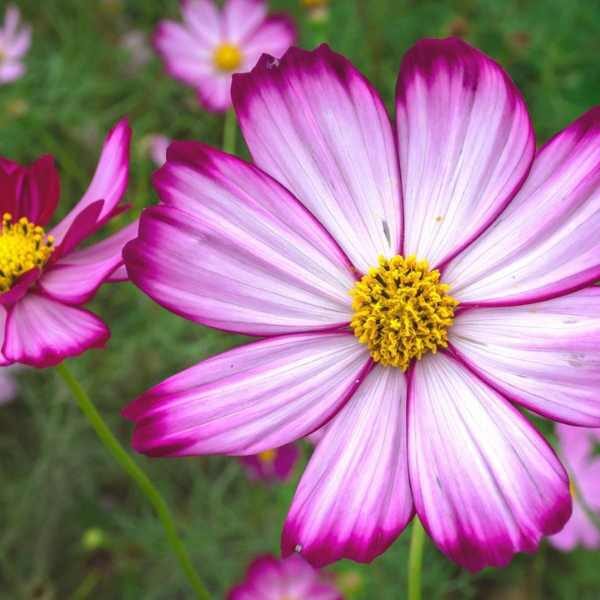Cosmos Candy Stripe
$4.49
Cosmos Bipinnatus
- Seed Count 600
- Proven Performer
- Annual
- Height 80 cm
In stock
Description
Cosmos Candy Stripe has beautiful white flowers with dark pink edges that are ideal for any garden and a proven performer! The single light pink flowers with a red striped edge are 8 to 10cm across with There’s something undeniably cheerful about Cosmos Candy Stripe. These old-fashioned annuals, with their beautiful white flowers with dark pink edges, evoke the kind of simple, carefree beauty that feels both timeless and refreshingly uncomplicated. If you’re after a flower that delivers colour without fuss, these seeds are a solid bet.
Cosmos Candy Stripe thrives in Australia’s sun-soaked climates, shrugging off dry spells and poor soils with a resilience that’ll make any gardener nod in approval. They’re the sort of flowers that look equally at home in a cottage garden, a wildflower meadow, or tucked into a corner of a backyard.
What I appreciate most about these cosmos is their unpretentious nature. They don’t demand pampering, yet they reward you with months of blooms, starting from late spring and stretching well into autumn. Their open-faced flowers are a magnet for pollinators, too—bees and butterflies flock to them, adding a lively buzz to the garden. They thrive on neglect and reseed easily making them a great choice for wildflower meadows or naturalized areas.
For those who love bringing the garden indoors, Cosmos Candy Stripe makes a charming cut flower. The stems hold up well in vases, their cheerful faces lasting days in a bouquet. Harvest the blooms in the early morning hours selecting stems with flowers that have just opened.
Whether you’re filling a border, supporting local pollinators, or just craving a burst of nostalgic colour, these seeds offer a straightforward, dependable kind of beauty—the kind that reminds you why gardening never goes out of style.
| Method: Sow direct or seedlings | Soil Temp: 10°C - 25°C |
| Cool Mountain: Nov - Dec | Germination: 7 - 10 days |
| Arid: Aug - Jan | Position: Part sun |
| Temperate: Sep-Nov, Mar-Jun | Row Spacing: 30cm apart |
| Sub Tropical: May - Oct | Planting Depth: 3 mm |
| Tropical: Jun - Aug | Harvest: 90 days |
Climate and Soil Requirements
Climate:
- Cosmos thrives in warm, sunny climates and is well suited to most regions in Australia.
Soil:
- Cosmos prefers well-draining soil with a pH between 6.0 and 8.0.
- It can tolerate poor soil conditions, including sandy or rocky soils, making it ideal for Australian gardens.
- Avoid overly rich or fertile soil, as this can lead to excessive foliage growth at the expense of flowers.
Planting Cosmos
Seed Sowing:
- Sow seeds directly into the garden bed or in seed trays.
- Scatter seeds on the soil surface and lightly cover with 3 mm of soil.
- Space seeds 30 cm apart to allow for growth.
- Water gently to avoid displacing the seeds.
Germination:
- Seeds typically germinate in 7=10 days.
- Keep the soil moist but not waterlogged during germination.
Transplanting:
- If starting seeds indoors, transplant seedlings outdoors once they are 10-15 cm tall and the weather is warm.
Care and Maintenance
Watering:
- Cosmos is drought tolerant once established.
- Water young plants regularly until they develop a strong root system.
- Mature plants only need watering during prolonged dry spells.
Fertilising:
- Avoid over fertilising, as this can reduce flowering.
- If necessary, apply a balanced, low nitrogen fertilizer once or twice during the growing season.
Deadheading:
- Regularly remove spent flowers to encourage continuous blooming.
- Deadheading also prevents self-seeding if you want to control the spread of Cosmos.
Pests and Diseases:
- Cosmos is relatively pest resistant but can occasionally attract aphids or spider mites.
- Treat infestations with insecticidal soap or neem oil.
- Ensure good air circulation to prevent fungal diseases like powdery mildew.
Companion Planting
Best Companion Plants
Vegetables:
- Tomatoes: Cosmos attracts pollinators like bees, which can improve tomato yields.
- Zucchini and Squash: Cosmos helps deter pests like aphids and whiteflies.
- Beans: The tall, airy structure of Cosmos provides light shade for beans without competing for nutrients.
Herbs:
- Basil: Cosmos and basil grow well together and attract beneficial insects.
- Dill: Both plants attract hoverflies, which prey on aphids.
Flowers:
- Marigolds: Marigolds repel nematodes and other pests, while Cosmos attracts pollinators.
- Zinnias: These flowers share similar growing conditions and create a vibrant, colourful garden.
- Sunflowers: Cosmos can fill in gaps around sunflowers and attract pollinators.
- Lavender: Both plants thrive in sunny, well-draining conditions and attract pollinators.
- Nasturtiums: These act as a trap crop for aphids, protecting Cosmos and other plants.
Plants to Avoid:
- Avoid planting Cosmos near plants that require rich, fertile soil, as Cosmos thrives in poorer conditions.
- Keep Cosmos away from aggressive growers that may overshadow or outcompete it.
Harvesting and Saving Seeds
Harvesting Flowers:
- Cut Cosmos flowers in the morning when they are fully open.
- Place them in a vase with fresh water for a long-lasting display.
Saving Seeds:
- Allow some flowers to remain on the plant until they fade and dry out.
- Collect the dried seed heads and remove the seeds.
- Store seeds in a cool, dry place for planting next season.
Troubleshooting Common Issues
Leggy Plants:
- Caused by insufficient sunlight.
- Ensure Cosmos receives at least 6 hours of direct sun daily.
Poor Flowering:
- Over fertilisation or overly rich soil can reduce blooms.
- Stick to low nitrogen fertilizers.
Self-Seeding:
- Cosmos can self-seed prolifically.
- Deadhead regularly to control spread.














1 review for Cosmos Candy Stripe